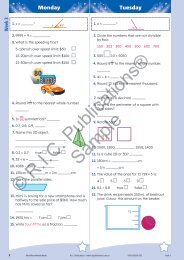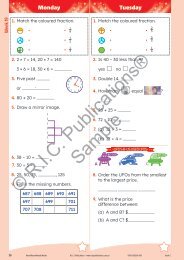PR-0552UK Primary Science - Book 2
You also want an ePaper? Increase the reach of your titles
YUMPU automatically turns print PDFs into web optimized ePapers that Google loves.
Rubbish in the classroom<br />
Caring for my locality ~ Activity 9<br />
Objectives<br />
• realise that there is both an<br />
individual and a community<br />
responsibility for taking care of<br />
the environment<br />
• become aware of ways in which<br />
the environment can be polluted<br />
or harmed<br />
Working scientifically<br />
• Questioning<br />
• Observing<br />
• Analysing (sorting and<br />
classifying)<br />
• Recording and communicating<br />
Designing and making<br />
• Exploring<br />
• Making<br />
Background information<br />
Rubbish is believed to be one of the<br />
major fire hazards in schools, as the<br />
contents of rubbish bins have often<br />
been used to start fires.<br />
Pupils should not handle the rubbish<br />
directly; they should wear gloves.<br />
It is a good idea to put plastic<br />
bags in the bins on the day of the<br />
investigation.<br />
Food packaging is necessary to<br />
protect food from germs, dirt and<br />
breakage as well as to make it look<br />
attractive and easy to use.<br />
Before the lesson<br />
Materials needed<br />
• Full classroom rubbish bins (some could be brought in from other classes to<br />
make it a sizable amount), large sheet of plastic or a tarpaulin to empty the<br />
bins on, rubber gloves for the handlers.<br />
Preparation<br />
• Have the plastic sheet or tarpaulin spread out and the bin(s) waiting to be<br />
emptied.<br />
The lesson<br />
Stimulus<br />
• Discuss the activities of the day and what has been thrown out. See if anyone<br />
can remember throwing anything out. Relate the activities to what is likely to<br />
be in the bins.<br />
What to do<br />
• Appoint some pupils to help with the distribution of the rubbish from the bins.<br />
(These pupils should have rubber gloves on.)<br />
• Tip the rubbish onto the sheet.<br />
• At first glance, discuss what is the most common rubbish seen.<br />
• Spread the rubbish and let the pupils discuss the different things they can<br />
see.<br />
• On the whiteboard, list the items found. Discuss how the amounts could be<br />
measured (e.g. weigh, count etc.).<br />
• Pupils begin the worksheet, choosing the three most common items (drawing<br />
items and filling in the chart).<br />
• When the exercise is complete, pupils can answer the questions about<br />
amounts.<br />
• Discuss recycling and what is needed to begin a programme in the class.<br />
• Pupils can complete the worksheet with their own ideas.<br />
After the lesson<br />
Answers<br />
• Teacher check<br />
Viewing Sample<br />
Additional activities<br />
• Unfold an empty cardboard box or milk carton and make a cardboard template<br />
of it. Use the template to design and make an attractive container for a new<br />
type of flavoured milk.<br />
• Make jam sandwiches and put them in different kinds of packages; e.g. foil,<br />
cling film, a plastic bag, a cardboard box, waxed paper, tissue and cellophane.<br />
Place the sandwiches on a shelf for three days, then test for freshness. Make<br />
a list, ranking freshest to stalest.<br />
• Estimate how much rubbish there is daily and then weigh it to check<br />
estimates.<br />
Display ideas<br />
• Cleaned items for recycling could be hung as class mobiles with labels<br />
attached.<br />
116 <strong>PR</strong>IMARY SCIENCE ~ Prim-Ed Publishing ~ www.prim-ed.com


















